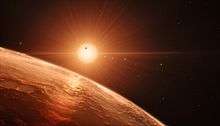LHS 1140
 Artist's impression of LHS 1140 and LHS 1140b. | |
| Observation data Epoch J2000.0 Equinox J2000.0 | |
|---|---|
| Constellation | Cetus |
| Right ascension | 00h 44m 59.31s[1] |
| Declination | −15° 16′ 16.7″[1] |
| Apparent magnitude (V) | 14.18[2] |
| Characteristics | |
| Evolutionary stage | Red dwarf |
| Spectral type | M4.5V[2] |
| Astrometry | |
| Radial velocity (Rv) | -13.23 ± 0.60[2] km/s |
| Proper motion (μ) | RA: 317[3] mas/yr Dec.: -589[3] mas/yr |
| Distance | 40.67 ± 1.37 ly (12.47 ± 0.42[2] pc) |
| Details[2] | |
| Mass | 0.146 ± 0.009 M☉ |
| Radius | 0.186 ± 0.013 R☉ |
| Luminosity | 0.002981 ± 0.00021 L☉ |
| Temperature | 3131 ± 100 K |
| Metallicity [Fe/H] | -0.24 ± 0.10 dex |
| Rotation | 131 d |
| Age | >5 Gyr |
| Other designations | |
| Database references | |
| SIMBAD | data |
| ARICNS | data |
LHS 1140 is a red dwarf in the constellation of Cetus. Based on its stellar properties, it is thought to be about 41 light-years away from the Sun.[2] 'LHS' refers to the Luyten Half-Second Catalogue of stars with proper motions exceeding half a second of arc annually.[4] The star is over 5 billion years old and has 15% of the mass of the Sun. LHS 1140's rotational period is 130 days. No flares have been observed.[5]
LHS 1140 has a rocky planet, LHS 1140b, orbiting it. The planet is a super-Earth in a habitable zone and transits the star. This should allow its atmosphere to be studied in future: the combination of the transiting super-Earth and the relatively small and nearby host star make this system one of the most promising known for atmosphere studies, along with the TRAPPIST-1 system. The mass of LHS 1140b is 6.7 ± 1.8 times Earth's and its radius is 1.4 ± 0.1 times as large,[2][6] giving it a density roughly 2.3 ± 0.6 times that of Earth.[2]
| Companion (in order from star) |
Mass | Semimajor axis (AU) |
Orbital period (days) |
Eccentricity | Inclination | Radius |
|---|---|---|---|---|---|---|
| b | 6.65 ± 1.82 M⊕ | 0.0875 | 24.73712 ± 0.00025 | <0.29 | 89.912 ± 0.071° | 1.43 ± 0.10 R⊕ |
The orbit of LHS 1140b is nearly circular with a radius of 0.09 AU. LHS 1140b orbits and transits the star every 24.7 days.[2] The planet was discovered in 2017 by the MEarth Project. Radial velocities were measured by High Accuracy Radial Velocity Planet Searcher.[5]
See also
References
- 1 2 Cutri, R. M.; et al. (2003). "2MASS All-Sky Catalog of Point Sources". VizieR On-line Data Catalog. 2246. Bibcode:2003yCat.2246....0C.
- 1 2 3 4 5 6 7 8 9 10 Dittmann, Jason A.; Irwin, Jonathan M.; Charbonneau, David; Bonfils, Xavier; Astudillo-Defru, Nicola; Haywood, Raphaëlle D.; Berta-Thompson, Zachory K.; Newton, Elisabeth R.; Rodriguez, Joseph E.; Winters, Jennifer G.; Tan, Thiam-Guan; Almenara, Jose-Manuel; Bouchy, François; Delfosse, Xavier; Forveille, Thierry; Lovis, Christophe; Murgas, Felipe; Pepe, Francesco; Santos, Nuno C.; Udry, Stephane; Wünsche, Anaël; Esquerdo, Gilbert A.; Latham, David W.; Dressing, Courtney D. (2017). "A temperate rocky super-Earth transiting a nearby cool star". Nature. 544 (7650): 333. PMID 28426003. arXiv:1704.05556
 . doi:10.1038/nature22055.
. doi:10.1038/nature22055. - 1 2 Salim, Samir; Gould, Andrew (2003). "Improved Astrometry and Photometry for the Luyten Catalog. II. Faint Stars and the Revised Catalog". The Astrophysical Journal. 582 (2): 1011. Bibcode:2003ApJ...582.1011S. arXiv:astro-ph/0206318
 . doi:10.1086/344822.
. doi:10.1086/344822. - ↑ Luyten, Willem Jacob, Catalogue of stars with proper motions exceeding 0"5 annually, University of Minnesota, 1979
- 1 2 Dickinson, David (19 April 2017). "Welcome to LHS 1140b: A Super-Earth in the Habitable Zone". Sky & Telescope. Retrieved 19 April 2017.
- ↑ Overbye, Dennis (19 April 2017). "A New Exoplanet May Be Most Promising Yet in Search for Life". New York Times. Retrieved 20 April 2017.
.jpg)
